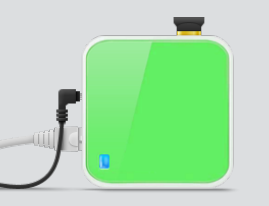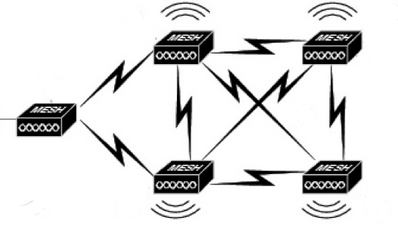How you are being watched while you walk around the mall
I previously published an article on visitor counting systems . Now I want to talk about a system that allows you to calculate:

The principle of the system is very simple - WiFi. Now many people have smartphones with a WiFi module. If it is turned on, then requests to search for networks are constantly sent to the air. It doesn’t matter if you are connected to any network or not. Requests are ongoing. The request contains a lot of information, including the unique MAC address of the device.
Here is an example of what the standard debian utility airdump can catch:

Knowing only the MAC address of the device and signal strength, you can learn a lot about the buyer:
Moreover, at least one of the suppliers of such solutions makes it possible to obtain a “portrait of the buyer”. If a person has got into the sensor coverage area, then you are provided with information on what other stores / cafes / restaurants this person was (provided that in these stores / cafes / restaurants there is a system from the same supplier). That will allow you to do targeted promotions with specific shops / cafes / restaurants. Knowing where your potential customers dine, you can do it cross-country with specific establishments based on accurate data. And after the action there is an opportunity to evaluate it in numbers.
A little technical information about a possible implementation method.
A TP-LINK household router (TL-MR3020 or equivalent) is used as a sensor. It has OpenWRT firmware installed with an additional software module, which is designed specifically for collecting statistics.

One of the routers acts as the main one, the rest as auxiliary. Either a full-fledged wired network with access points is being built, or a mesh network where only power is supplied to the slave access points. The main point is connected via a radio channel. Such a scheme allows you to reduce the cost of the entire complex, using cheaper and less productive routers as auxiliary (exclusively for collecting statistics) and the main router for its primary processing.
Mesh network reduces the cost of installation (you do not need to pull a separate cable to each point, just power it from the outlet).

The cost of equipment is very small, so even small cafes can afford such a system.
As a plus, on the basis of this equipment you can make hotspot and distribute Internet to visitors. When setting up authorization for an account on a social network, you will know almost a part of your audience by name, which will give even more space for targeted advertising.
And a few words about the scalability of a particular solution: it is possible to install a bluetooth module in the router and track bluetooth devices. Given the growth of the wearable electronics market, this will reach more visitors.
In conclusion, retail is studying its customer more closely, using the most modern technologies for this. The main thing is that he can stop in time and not cross that thin line when marketing research turns into total surveillance.
PS In PM, I’m ready to share some details of the introduction of such a system in our retail network.
- How many people passed by without going into the store;
- How many reentered;
- How much on average does a customer spend in a store and not only ...

The principle of the system is very simple - WiFi. Now many people have smartphones with a WiFi module. If it is turned on, then requests to search for networks are constantly sent to the air. It doesn’t matter if you are connected to any network or not. Requests are ongoing. The request contains a lot of information, including the unique MAC address of the device.
Here is an example of what the standard debian utility airdump can catch:

Knowing only the MAC address of the device and signal strength, you can learn a lot about the buyer:
- Did a man walk past a store or go inside;
- If the area is large, then by installing several sensors you can evaluate how a person moves between departments;
- How often does this customer go to the store;
- What is the average time a customer spends in a store;
- What other stores of this network does this customer go to;
- The number of regular customers is increasing or decreasing.
Moreover, at least one of the suppliers of such solutions makes it possible to obtain a “portrait of the buyer”. If a person has got into the sensor coverage area, then you are provided with information on what other stores / cafes / restaurants this person was (provided that in these stores / cafes / restaurants there is a system from the same supplier). That will allow you to do targeted promotions with specific shops / cafes / restaurants. Knowing where your potential customers dine, you can do it cross-country with specific establishments based on accurate data. And after the action there is an opportunity to evaluate it in numbers.
A little technical information about a possible implementation method.
A TP-LINK household router (TL-MR3020 or equivalent) is used as a sensor. It has OpenWRT firmware installed with an additional software module, which is designed specifically for collecting statistics.

One of the routers acts as the main one, the rest as auxiliary. Either a full-fledged wired network with access points is being built, or a mesh network where only power is supplied to the slave access points. The main point is connected via a radio channel. Such a scheme allows you to reduce the cost of the entire complex, using cheaper and less productive routers as auxiliary (exclusively for collecting statistics) and the main router for its primary processing.
Mesh network reduces the cost of installation (you do not need to pull a separate cable to each point, just power it from the outlet).

The cost of equipment is very small, so even small cafes can afford such a system.
As a plus, on the basis of this equipment you can make hotspot and distribute Internet to visitors. When setting up authorization for an account on a social network, you will know almost a part of your audience by name, which will give even more space for targeted advertising.
And a few words about the scalability of a particular solution: it is possible to install a bluetooth module in the router and track bluetooth devices. Given the growth of the wearable electronics market, this will reach more visitors.
In conclusion, retail is studying its customer more closely, using the most modern technologies for this. The main thing is that he can stop in time and not cross that thin line when marketing research turns into total surveillance.
PS In PM, I’m ready to share some details of the introduction of such a system in our retail network.
